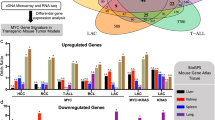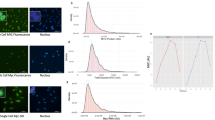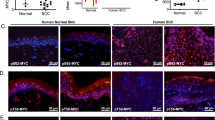Abstract
Teratocarcinoma cells provide us with a model system for the study of differentiation and development1–3. One of the best characterized cell lines, the embryonal carcinoma stem cell line F9, differentiates after treatment with retinoic acid (RA) and dibutyryl cyclic AMP into parietal endoderm4. This differentiation process is accompanied by the induction of several genes, for example, those encoding collagen IV, plasminogen activator and intermediate filaments like laminin4–6. In contrast, a marked reduction of stable messenger RNA has been observed for the gene encoding p53 and for c-myc7,8. Both cellular oncogenes seem to be involved in the regulation of cellular proliferation and neoplastic transformation8–12. For growth-arrested 3T3 fibroblasts, growth-factor-induced changes of myc RNA are controlled at the level of transcription13. In contrast, F9 cells provide a differentiation system in which cells are able to change from a tumorigenic state into non-dividing, non-tumorigenic endodermal cells5. The latter process enabled us to study the regulation of myc and p53 genes in the same cells at different stages of growth, tumorigenicity and differentiation. Here we report that down-regulation of stable myc and p53 RNA during irreversible differentiation of F9 cells occurs at the post-transcriptional level. Using an in vitro nuclear transcription assay14, we found that the polymerase II density on both genes remains constant during differentiation. In agreement with this interpretation, we detected myc RNA as stable transcripts in differentiated F9 cells after treatment of the cells with cyclo-heximide. The post-transcriptional regulatory mechanisms controlling p53 and myc stability follow different kinetics. Whereas the down-regulation of myc seems to be an early event of F9 differentiation occurring within the first 24 h, the post-transcriptional regulation of p53 occurs at a later stage (two to three days), possibly as a consequence of cell cycle changes.
This is a preview of subscription content, access via your institution
Access options
Subscribe to this journal
Receive 51 print issues and online access
$199.00 per year
only $3.90 per issue
Buy this article
- Purchase on Springer Link
- Instant access to full article PDF
Prices may be subject to local taxes which are calculated during checkout
Similar content being viewed by others
References
Martin, G. R. Science 209, 768–776 (1980).
Martin, G. R. Cell 5, 229–243 (1975).
Bernstine, E. G., Hooper, M. L., Grandchamp, S. & Ephrussi, B. Proc. natn. Acad. Sci. U.S.A. 70, 3899–3903 (1973).
Strickland, S. & Mahdavi, V. Cell 15, 393–403 (1978).
Strickland, S., Smith, K. K. & Marotti, K. R. Cell 21, 347–355 (1980).
Kurkinen, M., Barlow, D. P., Helfman, D. M., Williams, J. G. & Hogan, B. L. M. Nucleic Acids Res. 11, 6199–6209 (1983).
Reich, N. C., Oren, M. & Levine, A. J. Molec. cell. Biol. 3, 2143–2150 (1983).
Campisi, J., Gray, H. E., Pardee, A. B., Dean, M. & Sonenshein, G. E. Cell 36, 241–247 (1984).
Milner, J. & Milner, S. Virology 112, (1981).
Mercer, W. E., Nelson, D., De Leo, A. B., Old, L. J. & Baserga, R. Proc. natn. Acad. Sci. U.S.A. 79, 6309–6312 (1982).
Eliyahu, D., Raz, A., Gruss, P., Givol, D. & Oren, M. Nature 312, 646–649 (1984),
Kelly, K., Cochran, B. H., Stiles, C. D. & Leder, P. Cell 35, 603–610 (1983).
Greenberg, M. E. & Ziff, E. B. Nature 311, 433–438 (1984).
Groudine, M., Peretz, M. & Weintraub, H. Molec. cell. Biol. 1, 281–288 (1981).
McKnight, G. S. & Palmiter, R. J. biol. Chem. 254, 9050–9058 (1979).
Marzluff, W. F. Meth. cell Biol. 19, 317–331 (1978).
Wang, S. Y., La Rosa, G. J. & Gudas, L. J. Devl. Biol. 107, 75–86 (1985).
Mackall, J., Meredith, M. & Lane, D. Analyt. Biochem. 95, 270–275 (1979).
Dani, Ch. et al. Proc. natn. Acad. Sci. U.S.A. 81, 7046–7050 (1984).
Reitsma, P. H. et al. Nature 306, 492–494 (1983).
Jonak, G. J. & Knight, E. Jr Proc. natn. Acad. Sci. U.S.A. 81, 1747–1750 (1984).
Einat, M., Resnitzky, D. & Kimchi, A. Nature 313, 597–600 (1985).
Knight, E. Jr, Anton, E. D., Fahey, D., Friedland, B. K. & Jonak, G. J. Proc. natn. Acad Sci. U.S.A. 82, 1151–1154 (1985).
Howe, C. C., Lugg, D. K. & Overton, G. C. Molec. cell. Biol. 4, 2428–2436 (1984).
Rosenstaus, M. J., Sundell, C. L. & Liskay, M. R. Devl. Biol. 89, 516–520 (1982).
Carneiro, M. & Schibler, U. J. molec. Biol. 178, 869–880 (1984).
Hewish, D. R. & Burgoyne, L. A. Biochem. biophys. Res. Commun. 52, 504–510 (1973).
Schibler, U., Hagenbüchle, O., Wellauer, P. & Pittett, A. C. Cell 33, 501–508 (1983).
Maniatis, T., Fritsch, E. F. & Sambrook, J. Molecular Cloning: A Laboratory Manual, 331 (Cold Spring Harbor Laboratory, New York, 1982).
Kafatos, F. C., Jones, C. W. & Efstratiadis, A. Nucleic Acids Res. 7, 1541–1552 (1979).
Zakut-Houri, R. et al. Nature 306, 594–597 (1983).
Stanton, L. W., Watt, R. & Marcu, K. B. Nature 303, 401–406 (1983).
Marotti, K. R., Brown, G. D. & Strickland, S. Devl Biol. 108, 26–31 (1985).
Belayew, A. & Tilghman, S. M. Molec. cell. Biol. 2, 1427–1435 (1982).
Chirgwin, J. M., Przybyla, A. E., MacDonald, R. J. & Rutter, W. J. Biochemistry 18, 5294–5295 (1979).
Dani, Ch. et al. Proc. natn. Acad. Sci. 82 (in the press).
Author information
Authors and Affiliations
Rights and permissions
About this article
Cite this article
Dony, C., Kessel, M. & Gruss, P. Post-transcriptional control of myc and p53 expression during differentiation of the embryonal carcinoma cell line F9. Nature 317, 636–639 (1985). https://doi.org/10.1038/317636a0
Received:
Accepted:
Issue Date:
DOI: https://doi.org/10.1038/317636a0
This article is cited by
-
BAC transgenic mice provide evidence that p53 expression is highly regulated in vivo
Cell Death & Disease (2015)
-
Regulation of TFIIIB during F9 cell differentiation
BMC Molecular Biology (2010)
-
Retinoids and apoptosis in cancer therapy
Apoptosis (1996)
Comments
By submitting a comment you agree to abide by our Terms and Community Guidelines. If you find something abusive or that does not comply with our terms or guidelines please flag it as inappropriate.



